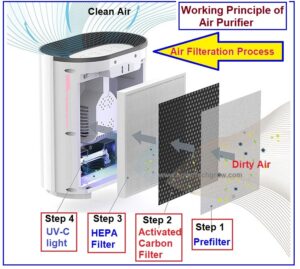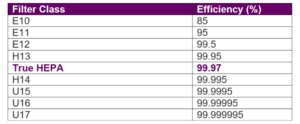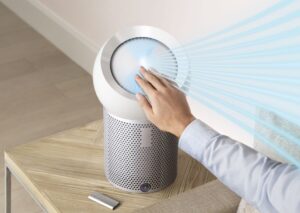How does an air purifier clean dirty air?
- The air purifier used various filtration screens for cleaning polluted air in the room
- Outside dirty air is unducted by the fan passes through a system of filters and purified air is released to the outside
- In most air purifiers available in the market, the polluted or dirty air is drawn through membranes in at the side or rear of the air purifier.
- The filtered or cleaned air is released at the top
- This is continuous air circulation in the room and better cleaning of the air is maintained.
- The working principle of an air purifier involves the use of various techniques to remove pollutants and contaminants from the air
- The exact mechanism used by different air purifiers may vary, but here is a general overview of how most air purifiers work:
-
- Air Intake: The air purifier pulls in air from the surrounding environment.
- Filtration: The air is then passed through a filter that captures pollutants, such as dust, allergens, and other airborne particles.
- Purification: Once the air has been filtered, it is then passed through a purification system which removes any remaining contaminants from the air, such as volatile organic compounds (VOCs), odors, and smoke.
- Discharge: The purified air is then discharged back into the surrounding environment, free of pollutants and contaminants.
- Some air purifiers may also use additional technologies, such as UV light or ionization, to further enhance the purification process. For example, UV light can be used to kill bacteria and viruses, while ionization can help remove particles that are too small to be captured by a filter.
Steps of Air purifier filtration
The quality of the air purification device depends on the quality of each of these filters. Note the following things is worth while choosing an air purifier for yourself.
- Step 1: In an air purifier, the polluted air first passes through a pre-filter
- Step 2: It is responsible for filtering out the biggest dirt clusters, dust, and hair, thus protecting the other filters from premature wear
- Step 3:
- The next filter, through which the air passes is the carbon filter, which absorbs Volatile Organic Compounds (VOCs) and unpleasant odors. The last stage of filtration is the High-Efficiency Particulate Air Filter (HEPA) filter
- It stops the smallest contaminants at almost 100% efficiency
- Step 4: UV C light
What are the Major Benefits of an Air Purifier
- Healthy life: Relieves Symptoms of Asthma
- Eliminates Harmful Chemicals from Indoor Environments
- Improves Sleep
- Neutralizes Unpleasant Odors
- Reduces the Chances of Airborne Diseases
- Removes Harmful gases
- Eliminates Hazardous Asbestos Particles. …
- Can Increase Life Expectancy/span
What is filtration efficiency?
- When choosing a HEPA filter (High-Efficiency Particulate Air Filter), we can refer to their classification
- The higher it is, the higher the degree of filtration. The most common filters found in air purifiers are EPA (Efficiency Particulate Air) class E12 (commonly called H12), or high-efficiency H13 (the letter H stands for High)
- Even E12 (H12) rated filters remove ≥ 99.95% of pollutants
- For more demanding users, we recommend an air purifier with a filter class H13 that achieves an efficiency of ≥ 99.97 %.
Carbon Filter Thickness
- The situation is slightly different in the case of active carbon filters. Here, the more the better.
- The thickness of the active carbon layer is very important. The thicker the layer, the greater the air contact with the surface of the carbon.
Can an air purifier remove dust?
- An air purifier draws dirty air with dust which passes through the membrane or filter but the particles are trapped in the fiber
- An air purifier removes all the dust particles carried along with polluted air

Selection of an Air Purifier
When selecting an air purifier, there are several factors you should consider:
- Room Size: Consider the size of the room where you plan to use the air purifier. You will need an air purifier that is powerful enough to clean the air in the room. You can find this information on the product specifications.
- Type of Filter: Different air purifiers use different types of filters. Some common types of filters include HEPA filters, activated carbon filters, and UV filters. Each type of filter has its own benefits and limitations, so it’s important to choose the right filter for your specific needs.
- Noise Level: Consider the noise level of the air purifier. Some air purifiers are louder than others, so it’s important to choose one that won’t disturb your daily activities.
- Energy Efficiency: Look for an air purifier that is energy efficient. This will help you save money on your electricity bill in the long run.
- Additional Features: Some air purifiers come with additional features, such as air quality sensors, automatic shut-off, and remote control. Consider if any of these additional features are important to you.
- Brand and Price: Finally, consider the brand and price of the air purifier. Look for a reputable brand with good reviews, and choose a price that fits your budget.
By considering these factors, you can find an air purifier that will meet your needs and help you improve the air quality in your home or office.
Role of Sensors that react to changes in air quality
Other important elements that affect the performance of air purifiers are the sensors that measure air quality and the light sensor
- Check what sensors the chosen model has because it will depend on how it works, how fast it reacts, and the accuracy of the automatic mode
- Properly working in automatic mode will ensure rapid removal of the resulting pollution, and then the device goes into silent mode, and also ecological
- Higher accuracy and faster response to changing air quality are provided by a laser sensor, so it is worth investing in an air purifier that has it.
How to operate an air purifier?
- It’s also worth paying attention to how you operate it.
- Whether the model you choose is intuitive, whether there are basic buttons on the casing, such as mode selection, and fan speed, whether there is information about air quality, the need to change filters, and whether you can turn off the backlight.
- Users who expect more should choose an air purifier equipped with a WiFi module that allows you to control the device and read the operating parameters and air quality on your phone or tablet.
What is the power consumption of an air purifier?
- The functions discussed above, such as operating modes and automatic programs, greatly reduce the power consumption of the air purifier
- The average power consumption in normal mode varies between 15-20 W
- In night mode, this value should be less than 10 watts, while in the maximum mode, it may even be twice as high as in normal mode
- Keep in mind, however, that this program is usually used only temporarily
Why regular cleaning of the purifier is needed?
- The last but important task related to the performance of our device is the cleaning method
- The filters used in air purifiers can last up to one year.
- To work efficiently, we should change filters periodically (after one or two years).
- You should also check whether you can do it yourself and whether it is intuitive
- It is also worth checking if you can wash the pre-filter, or if you can additionally remove the air inlet and outlet panels, which become dirty over time and can be tricky to clean
- You must know how air purifiers work. When choosing a model, remember to pay attention to its performance (recommended room size), the filter system used and its quality, the way and the possibility of handling
Summary
- Overall, the goal of an air purifier is to provide cleaner air by removing pollutants and contaminants from the environment
- Air filters can be beneficial for people who suffer from allergies, asthma, or other respiratory problems
- Healthy People for those who want to maintain a healthy indoor environment.



